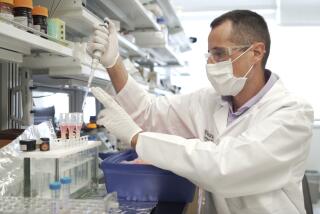Alzheimer’s Might Be Caused by Extra Gene, Researchers Discover
An international team of scientists reported today that they may have discovered a potential mechanism by which Alzheimer’s disease develops.
The finding, published in Science magazine, is the most recent in a remarkable series of new insights into Alzheimer’s.
In a matter of about four months, researchers now have discovered genetic markers that may help predict susceptibility to the disease, a protein that can be used to diagnose the disease and a gene that may be involved in the genesis of the disease. In addition, they have discovered that aging animals, such as dogs, monkeys, orangutans and polar bears, also develop the disease, thus providing convenient research models.
While the discoveries do not mean that a cure for Alzheimer’s is imminent, they do provide the best information yet into the nature of the disease and how it develops, and those insights may ultimately lead to some treatments or even preventive measures.
The newest report says that Alzheimer’s victims have extra copies of a recently discovered gene that is suspected to be a cause of the disease. According to the researchers, the extra copies of that gene produce abnormal quantities of a protein that interferes with thought processes.
“It’s a very exciting story because it leads to many new avenues of research on Alzheimer’s,” said neurologist Henry Wisniewski of the Institute for Basic Research in New York City.
Alzheimer’s affects as many as 2.5 million Americans, roughly one in every 11 people over the age of 65. Its victims typically begin to lose their ability to recall names, places they left things and other minutiae of everyday life. Eventually, some stop recognizing their own family members and lose the ability to care for themselves.
Plaques and Tangles
Alzheimer’s can be accurately diagnosed only after death, when autopsies reveal large quantities of abnormal, cement-like structures in the brain called plaques and tangles. The plaques and tangles are also found in large numbers in the brains of adult victims of Down’s syndrome--a birth defect that is the leading cause of mental retardation--and in much smaller quantities in the brains of healthy elderly individuals.
The principal component of the abnormal structures is a protein called amyloid.
In 1984, pathologist George G. Glenner of the University of California, San Diego, determined the amino acid sequence of the amyloid protein. His discovery touched off the current spate of research because it enabled scientists to search for the gene that codes for amyloid, using recombinant DNA techniques.
Since last November, three groups of researchers have independently found the gene. They all located the gene on a narrow region of Chromosome 21, one of the 46 chromosomes (23 pairs) in which human genetic information is encoded.
Last month, another team of researchers at Massachusetts General Hospital in Boston reported that they had found a genetic marker associated with Alzheimer’s in studies of four families with an inherited form of the disease.
They found the marker in the same region of Chromosome 21 where the amyloid gene had been found, hinting that the gene might be a cause of Alzheimer’s.
That suspicion was apparently confirmed by today’s report, written by Dmitry Goldgaber and D. Carleton Gajdusek of the National Institute of Neurological and Communicative Diseases and Stroke near Washington, and Jean-Maurice Delabar of the National Center for Cancer Research in Paris and their colleagues.
Healthy Individuals
The report found that Chromosome 21 in cells from three Alzheimer’s victims contained three copies of the gene for the amyloid protein rather than the two copies found in healthy individuals.
They also found this same duplication in seven Down’s syndrome victims, which apparently explains why Down’s victims develop the same plaques and tangles as Alzheimer’s victims.
“If our finding holds true for a larger number of patients,” Delabar said in a telephone interview, “it will show that we have found the genetic defect responsible for Alzheimer’s.”
Such confirmation may come soon. Molecular geneticist Miriam Schwebel of the Boston University School of Medicine said in an interview that next month at a meeting in New York, she will report having found a similar duplication. It was Schwebel who in 1985 proposed that there were multiple copies of the then-undiscovered amyloid gene. She said she is “really delighted” that her hypothesis had been confirmed.
Wisniewski has also found evidence for multiple copies of the gene.
But Rudolph Tanzi of Children’s Hospital in Boston said, “We are going to have to look at a much larger number of Alzheimer’s victims before we have a clear idea about what is going on.”






